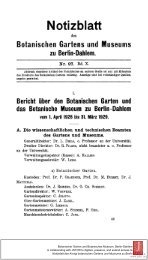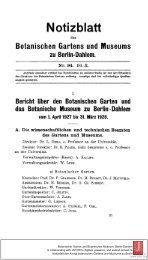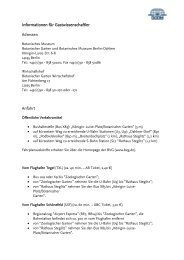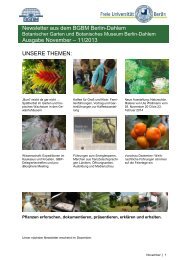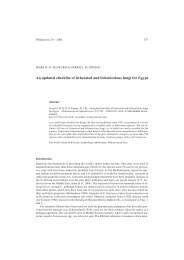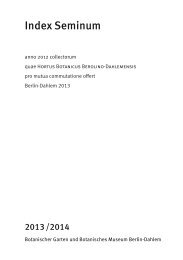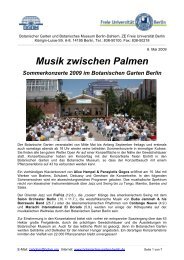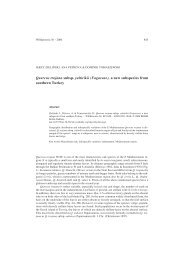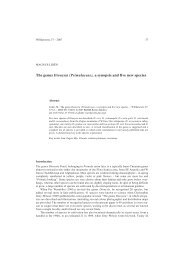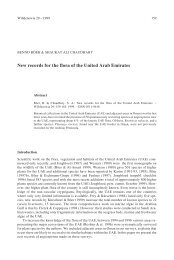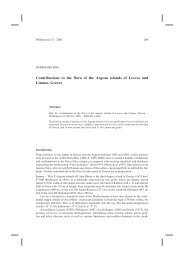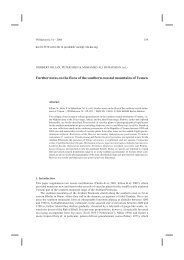Further new Taraxacum species (Asteraceae, Cichorieae) from ...
Further new Taraxacum species (Asteraceae, Cichorieae) from ...
Further new Taraxacum species (Asteraceae, Cichorieae) from ...
Create successful ePaper yourself
Turn your PDF publications into a flip-book with our unique Google optimized e-Paper software.
Willdenowia 36 – 2006 693<br />
HANS ØLLGAARD<br />
Notulae ad floram euro-mediterraneam pertinentes No. 21<br />
<strong>Further</strong> <strong>new</strong> <strong>Taraxacum</strong> <strong>species</strong> (<strong>Asteraceae</strong>, <strong>Cichorieae</strong>) <strong>from</strong><br />
northern Europe<br />
Abstract<br />
Øllgaard, H.: <strong>Further</strong> <strong>new</strong> <strong>Taraxacum</strong> <strong>species</strong> (<strong>Asteraceae</strong>, <strong>Cichorieae</strong>) <strong>from</strong> northern Europe. –<br />
Willdenowia 36: 693-706. – ISSN 0511-9618; © 2006 BGBM Berlin-Dahlem.<br />
doi:10.3372/wi.36.36205 (available via http://dx.doi.org/)<br />
Five <strong>new</strong> <strong>species</strong> of <strong>Taraxacum</strong> <strong>from</strong> northern Europe (T. freticola, T. leptoscelum, T. nigrescens, T.<br />
opertum, and T. palmgrenii) are validly named, described and discussed, and their known distribution<br />
is presented. All are members of T. sect. Ruderalia. For two <strong>species</strong> known by illegitimate<br />
names (later homonyms), <strong>new</strong> names are proposed: T. homoschistum, T. longiconicum.<br />
Key words: Compositae, dandelions, taxonomy.<br />
Herbarium abbreviations follow Holmgren & Holmgren (1998-). A list of specimens seen, in<br />
addition to the type material, is given in an electronic supplement to this paper at http://www.<br />
bgbm.org/willdenowia/willd36/Ollgaard.htm<br />
<strong>Taraxacum</strong> (sect. Ruderalia) freticola [H. Øllg. in Mirek & al. 2002: 165, nom. nud., ex] H.<br />
Øllg., sp. nov.<br />
Holotype: Denmark, Nordjylland (N Jutland), “Distr. 11, Hadsund, “Hornbechsvej, ved en sti””,<br />
56°43'0''N, 10°06'5''E, 2.5.1981, Øllgaard HØ-81-33 (C); isotypes: HØ-81-32 (B), HØ-81-29 (L),<br />
HØ 81-30, HØ 81-31 (S). – Fig. 1.<br />
Planta mediae magnitudinis, 25-35 cm alta, rosula ± erecta. Folia pallide viridia, omnia lobata<br />
subglabra immaculata, petiolo anguste alato (vel in speciminibus valde expositis late alato)<br />
pallido (in foliis interioribus rubescente), nervo medio viridi vel sordide brunnescente, striolis<br />
nullis. Lobi laterales utrinque c. 4 recurvi integri deltoidei, margine distali convexo vel sinuato<br />
integro, apice subacuminato subacuto, margine proximali fere recto integro. Lobus terminalis<br />
foliorum exteriorum et mediorum mediae magnitudinis obtusiusculus, interiorum major fere<br />
obtusus. Interlobia bene definita angulata parum crispa, plerumque viridia. Scapus glabrescens,
694 Øllgaard: <strong>Further</strong> <strong>new</strong> <strong>Taraxacum</strong> <strong>species</strong> (<strong>Asteraceae</strong>, <strong>Cichorieae</strong>) <strong>from</strong> northern Europe<br />
Fig. 1. <strong>Taraxacum</strong> freticola – holotype specimen.
Willdenowia 36 – 2006 695<br />
sub involucro valde araneosus. Involucrum viride parce pruinosum. Squamae exteriores lanceolatae,<br />
15-16 mm longae, 4-4.9 mm latae, plerumque leviter et sordide violascentes, marginibus<br />
planis non hyalinis, apice non vel parce corniculato, curvato-reflexae. Squamae<br />
interiores latitudine inter se fere aequales. Calathium circa 55 mm diametro luteum modice<br />
densum convexum. Ligulae planae vel subcanaliculatae, denticulis apicalibus luteis, marginales<br />
subtus stria ipsius ligulae angustiore cano-rubescente ornatae. Antherae polliniferae, grana<br />
pollinis diametro variabilia. Stigmata virescentia. Achaenium fusco-stramineum, pyramide<br />
inclusa 4.2-4.4 mm longum, superne spinulis mediae longitudinis subrobustis rectis instructum,<br />
pyramide 0.8-1 mm longa cylindrica laevi. Rostrum = 12 mm longum. Pappus albus.<br />
As a member of <strong>Taraxacum</strong> sect. Ruderalia, T. freticola is a rather small to medium-sized <strong>species</strong>,<br />
25-35 cm tall, with a ± erect rosette of very pale green, only indistinctly hairy, unspotted<br />
leaves. The petioles are narrowly winged (more broadly in fully exposed specimens), pale in<br />
outer and ± reddish in inner leaves. The midrib is green to indistinctly brownish and lacks<br />
striolate pattern. Alle leaves are distinctly lobed, with c. 4 lobe pairs. The side lobes are recurved,<br />
undivided, with the distal margin convex or s-curved, usually entire, and with a somewhat<br />
acuminate, medium acute tip. The proximal lobe margin is almost straight or irregular,<br />
entire or subulate-dentate. The terminal lobe of the outer and middle leaves is medium-sized,<br />
somewhat larger in the inner leaves, and usually almost obtuse. The interlobes are well differentiated,<br />
angular, only faintly plicate and usually green.<br />
The scapes are mostly glabrescent but hairy under the involucres. The involucre is dark<br />
green, only faintly pruinose. The outer bracts are 15-16 × 4-4.9 mm, usually somewhat brownish<br />
violet tinged, regularly arranged, ± curved-reflexed. The margins of the outer bracts are flat,<br />
without hyaline border and without corniculation near the tip. The inner bracts are almost<br />
equally wide, not coalescent. The flower head is c. 55 mm in diameter, medium yellow, medium<br />
dense, with a ± convex profile. The ligules are flat or canaliculate, with yellow apical teeth, the<br />
outer circle has a narrow, indistinct reddish grey stripe on the underside. Pollen is present, with<br />
grains of obviously varying diameter. The stigmas are discoloured.<br />
The achenes are straw-coloured to greyish brown, 4.2-4.4 mm long (incl. the 0.8-1 mm long,<br />
cylindrical, smooth cone). The achene spinules are medium long, medium strong, straight. The<br />
rostrum is = 12 mm long. The pappus is white.<br />
Discussion. – Because of its lobation and reflexed rather broad outer bracts <strong>Taraxacum</strong> freticola<br />
is best placed in an informal group of morphologically related <strong>species</strong> within T. sect. Ruderalia,<br />
series Retroflexa. In this group it stands out by its rather pale petioles, the almost obtuse end<br />
lobes, and the often dirty purplish, unbordered outer bracts. The somewhat acuminate lobe tips<br />
resemble those of T. oxyrhinum Sahlin which, however, has darker green leaves and only c.<br />
3.5 mm wide outer bracts. <strong>Further</strong>more, the latter <strong>species</strong> usually has at least some obtuse lobe<br />
tips, and in some leaves the midribs tend to be brownish adaxially for almost the total length.<br />
Distribution. – Denmark and Poland.<br />
<strong>Taraxacum</strong> (sect. Ruderalia) homoschistum H. Øllg., nom. nov. ≡ <strong>Taraxacum</strong> hastatum Markl.<br />
in Acta Soc. Fauna Fl. Fenn. 55(5): 8. 1926 [non Brenner 1925: 57]. – For the holotype, see<br />
Lundevall & Øllgaard (1999: 71).<br />
Notes. – This <strong>species</strong> was first described by Marklund (1926) as <strong>Taraxacum</strong> hastatum, and until<br />
1982 (see below) that name was in common use. Saarsoo & Haglund (1962: 528) regarded T.<br />
hastatum Markl. and T. undulatiflorum M. P. Christ., published in 1936, as one <strong>species</strong> that they<br />
named T. hastatum, either being unaware of or ignoring Brenner’s earlier T. hastatum. Jokela<br />
(1963: 26) likewise maintained the name T. hastatum Markl., but included both T. undulatiflorum<br />
and T. hastatum Brenner in synonymy. In Hagendijk & al. (1982: 146) T. undulatiflorum<br />
is accepted and regarded as identical with T. hastatum Markl. but different <strong>from</strong> T. hastatum<br />
Brenner. However, the photograph in Hagendijk & al. (1982: fig. 205) is in fact T. hastatum
696 Øllgaard: <strong>Further</strong> <strong>new</strong> <strong>Taraxacum</strong> <strong>species</strong> (<strong>Asteraceae</strong>, <strong>Cichorieae</strong>) <strong>from</strong> northern Europe<br />
Fig. 2. <strong>Taraxacum</strong> homoschistum – specimen Brandt-Pedersen & Øllgaard HØ-03-21 (herb. Øllgaard) (see<br />
character tabulation in Table 1).<br />
Fig. 3. <strong>Taraxacum</strong> undulatiflorum – specimen <strong>from</strong> Denmark, Jylland, Århus, 2.5.2002, Øllgaard HØ-02-183<br />
(herb. Øllgaard) (see character tabulation in Table 1).
Willdenowia 36 – 2006 697<br />
Table 1. Comparison of leaf lobes of <strong>Taraxacum</strong> homoschistum and T. undulatiflorum.<br />
Lobe pairs ± symmetrical, resembling<br />
bird’s wings<br />
Disposition very regular in density, shape<br />
and direction<br />
Division rarely (only in extreme modifications)<br />
cleft by a deep incision<br />
T. homoschistum T. undulatiflorum<br />
not quite symmetrical, not reminding<br />
of bird’s wings<br />
irregular in density (often more spaced in<br />
proximal leaf half), shape and direction<br />
often cleft by a ± deep incision<br />
Distal half ± gradually narrowing towards the tip usually ± linear<br />
Proximal margin at the base, perpendicular to the midrib at the base, often antrorse<br />
Marginal teeth if present, are small and mainly usually present, especially on the lobe<br />
in the interlobes<br />
margins, but also in the interlobes,<br />
often very long<br />
Markl. (= T. homoschistum). Kirschner & Stepánek (1983: 443) question whether T. hastatum<br />
Markl. and T. undulatiflorum are conspecific. The T. undulatiflorum illustration in Dudman &<br />
Richards (1997: 187) again represents T. homoschistum.<br />
<strong>Taraxacum</strong> homoschistum and T. undulatiflorum are different but morphologically related,<br />
medium-sized <strong>species</strong> with ± pale leaf petioles and recurved, greenish to irregularly and slightly<br />
reddish outer bracts of medium length and width, and with medium-sized flower heads,<br />
polliniferous anthers and somewhat greenish stigmas. They are separated mainly by leaf characters,<br />
as seen <strong>from</strong> the photographs (Fig. 2 and 3) and Table 1.<br />
Distribution. – Both <strong>species</strong> are known <strong>from</strong> Britain, the Czech Republic, Denmark, Finland,<br />
Germany, the Netherlands and Sweden, T. homoschistum also <strong>from</strong> Norway.<br />
<strong>Taraxacum</strong> (sect. Ruderalia) leptoscelum [Sahlin ex H. Øllg. in Glowacki & al. 2001: 68, in<br />
Mirek & al. 2002: 167, Øllgaard & al. 2002: 29, nom. nud., ex] H. Øllg., sp. nov.<br />
Holotype: Germany, “Hessen, Kreis Fritzlar: Fritzlar, vall i utkanten av staden mot SE” [cultivated<br />
grass field on the SE outskirts of the city], 51°07'2''N, 9°17'3''E, 7.5.1975, Sahlin 64661<br />
(B). – Fig. 4.<br />
Planta mediae magnitudinis sed sat gracilis, 20-35 cm alta, rosula ± erecta. Folia saturate viridia,<br />
omnia lobata subglabra immaculata, petiolo longo angusto rubri-purpureo, nervo medio viridi vel<br />
sordide brunnescente, striolis nullis. Lobi laterales utrinque (3-)4 recurvi integri deltoidei,<br />
margine distali plerumque regulariter convexo integro, apice subacuto, margine proximali fere<br />
recto integro vel parce subulato-dentato. Lobus terminalis foliorum exteriorum et mediorum<br />
parvus vel mediae magnitudinis, obtusiusculus, interiorum major. Interlobia ad medium folii<br />
longa (in partem distalem breviora), angusta, bene definita, angulata, parum crispa, parce piceata<br />
vel saepe viridia. Scapus glabrescens, sub involucro valde araneosus. Involucrum viride parce<br />
pruinosum. Squamae exteriores sat parvae (10-11 mm longae, c. 2.5 mm latae), lanceolatae, laete<br />
vel obscure virides, marginibus planis non hyalinis, apice non vel parce corniculato, ± patentes<br />
vel paulo curvato-reflexae. Squamae interiores latitudine inter se fere aequales. Calathium 45-<br />
55 mm diametro, modice densum vel densum, convexum, modice luteum. Ligulae planae vel partim<br />
subcanaliculatae, denticulis apicalibus luteis, marginales subtus stria ipsius ligulae angustiore<br />
rubro-canescente ornatae. Antherae polliniferae, grana pollinis diametro variabilia.<br />
Stigmata virescentia. Achaenium fusco-stramineum pyramide inclusa 3.6-3.8 mm longum,<br />
superne spinulis mediae longitudinis modice robustis rectis vel recurvis instructum, pyramide<br />
0.4-0.5 mm longa cylindrica laevi. Rostrum 10-11 mm longum. Pappus albus.
698 Øllgaard: <strong>Further</strong> <strong>new</strong> <strong>Taraxacum</strong> <strong>species</strong> (<strong>Asteraceae</strong>, <strong>Cichorieae</strong>) <strong>from</strong> northern Europe<br />
Fig. 4. <strong>Taraxacum</strong> leptoscelum – holotype specimen.
Willdenowia 36 – 2006 699<br />
<strong>Taraxacum</strong> leptoscelum is a medium-sized but rather delicate plant for its section, 20-35 cm tall,<br />
with a ± erect rosette of pure green, glabrescent, unspotted leaves. The petioles are long,<br />
unwinged, distinctly to strongly purplish red. The midrib is green to faintly reddish or brownish<br />
and lacks a striolate pattern. All leaves are distinctly lobed, with mostly (3-)4 lobe pairs. The<br />
lobes are recurved and entire, usually with a regularly convex entire distal margin and a medium<br />
acute tip. The proximal lobe margin is almost straight, entire or subulate-dentate. The terminal<br />
lobe is small to medium-sized, or (in inner leaves) sometimes large, without a well-defined tip.<br />
The interlobes are usually unwinged, long in the middle part but shorter in the distal half of the<br />
leaf, flat, only faintly tar-blotched or often green.<br />
The scapes are mostly glabrescent, but distinctly arachnoid under the involucre. The involucres<br />
are medium green to dark green, not (or indistinctly) pruinose. The outer bracts are rather small,<br />
10-11 × c. 2.5 mm, lanceolate, light to dark greyish green, ± horizontal to somewhat curved-reflexed,<br />
their margins flat and unbordered and the tip without distinct corniculation. The inner<br />
bracts are not coalescent. The flower head in full bloom is 45-55 mm in diameter, medium dense to<br />
dense, with a convex profile, medium yellow. The ligules are flat or partly canaliculate, with yellow<br />
apical teeth, the outermost circle beneath with a narrow indistinctly reddish grey stripe. Pollen<br />
is produced, the pollen grains of distinctly varying diameter. The stigmas are discoloured.<br />
The achenes are brownish grey, 3.6-3.8 mm long (including the cone). The cone is 0.4-0.5 mm<br />
long, cylindrical, smooth. The achene spinules are medium long, medium strong, straight to recurved.<br />
The rostrum is 10-11 mm long. The pappus is white.<br />
Discussion. – Labels on the holotype sheet, by C. I. Sahlin and M. Kääntönen respectively, mention<br />
two <strong>species</strong> morphologically close to <strong>Taraxacum</strong> leptoscelum: T. deltoideum G. E. Haglund<br />
and T. distinctum H. Lindb. The latter resembles T. leptoscelum in having long, narrow and purple-coloured<br />
petioles, but the side lobes in T. leptoscelum are fewer (T. distinctum: 5-6pairs),<br />
more strongly curved, the interlobes are longer, and the outer bracts more recurved. T.<br />
deltoideum is more robust, has greyish green leaves and somewhat broader, strongly reflexed<br />
outer bracts.<br />
Distribution. – Czech Republic, Denmark, Germany, Poland and Slovakia.<br />
<strong>Taraxacum</strong> (sect. Borea) longiconicum H. Øllg., nom. nov. ≡ <strong>Taraxacum</strong> longipyramidatum<br />
Rail. in Aquilo, Ser. Bot. 14, App.: 28. 1977 [non Schischkin 1964: 735]. – For the holotype, see<br />
Lundevall & Øllgaard (1999: 108).<br />
Note. – Judging <strong>from</strong> the photograph (Railonsala 1976: 22) <strong>Taraxacum</strong> longiconicum belongs in<br />
T. sect. Borea (s.str.), a placement also supported by Railonsala’s (1976: 10) comment: “is<br />
closely related to T. remotijugum Lindb. fil.” (= T. humile Brenner), a member of T. sect. Borea.<br />
Railonsala’s (1977: 28) description of T. longipyramidatum confirms the sectional position, but<br />
apart <strong>from</strong> the remark cited above the protologue has no discussion of the <strong>species</strong>. Until now I<br />
have not been able to study original specimens, so that assessment of the exact affinity, and indeed<br />
confirmation of distinctness, of T. longipyramidatum must await further study.<br />
<strong>Taraxacum</strong> (sect. Ruderalia) nigrescens [H. Øllg. in Øllgaard & al. 2002: 21, in Mirek & al.<br />
2002: 169, nom. nud., ex] H. Øllg., sp. nov.<br />
Holotype: Denmark, distr. 34, Langeland, “Rudkøbing tds. E, road A 9 at 22.1 km, at the southern<br />
Longelse exit, moist mossy road verge”, 54°56'0''N 10°48'0''E, 8.5.2001, Brandt-Pedersen &<br />
Øllgaard HØ-01-106 (C [2 parts of the same individual]). – Fig. 5.<br />
Planta robusta mediae magnitudinis, 20-40 cm alta, rosula patente. Folia subcanescenti-viridia,<br />
omnia lobata subglabra immaculata, petiolo ± alato pallido, nervo medio viridi vel sordide<br />
brunnescente, striolis nullis. Lobi laterales utrinque 5-6 recurvi integri vel interdum profunde<br />
fissi, deltoidei, margine distali irregulariter sinuato vel convexo, integro vel interdum dente
700 Øllgaard: <strong>Further</strong> <strong>new</strong> <strong>Taraxacum</strong> <strong>species</strong> (<strong>Asteraceae</strong>, <strong>Cichorieae</strong>) <strong>from</strong> northern Europe<br />
Fig. 5. <strong>Taraxacum</strong> nigrescens – holotype specimen.
Willdenowia 36 – 2006 701<br />
longo robusto praedito, apice modice acuto, margine proximali saepius fere recto, raro dente<br />
conspicuo munito. Lobus terminalis parvus vel mediae magnitudinis, subacutus vel subobtusus.<br />
Interlobia bene definita angulata ± crispa, plerumque extenuato-piceata vel sordide viridia.<br />
Scapus glabrescens, sub involucro valde araneosus. Involucrum subobscure viride valde<br />
pruinosum. Squamae exteriores breviores latiores, 12-13 mm longae, 4.5-6 mm latae, apiculatae,<br />
supra canovirides subtus obscure virides vel saepe sordide violaceae regulares erecto-patentes<br />
vel patentes, marginibus planis non vel angustius hyalinis, prope apicem saepe incrassatae sed<br />
non corniculatae. Squamae interiores latitudine inter se fere aequales vel interdum inaequilatae<br />
et ± cohaerentes. Calathium 55-60 mm diametro luteum, modice densum vel densum, convexum.<br />
Ligulae planae vel partim subcanaliculatae, denticulis apicalibus obscuris, subtus stria ipsius<br />
ligulae angustiore rubescenti-grisea ornatae. Antherae polliniferae, grana pollinis diametro<br />
variabilia. Stigmata virescentia. Achaenium fusco-stramineum, pyramide inclusa 3.9-4.1 mm<br />
longum, superne spinulis mediae longitudinis subrobustis vel robustioribus rectis instructum,<br />
pyramide 0.6-0.7 mm longa cylindrica laevi. Rostrum 10-11 mm longum. Pappus albus.<br />
<strong>Taraxacum</strong> nigrescens is a robust, medium-sized, 20-30 cm tall plant with a patent rosette of<br />
greyish green, indistinctly hairy, unspotted leaves. The petioles are ± winged, pale on the abaxial<br />
side (usually with no trace of red). The midrib is dirty green to distinctly brownish and lacks a<br />
striolate pattern. All leaves are distinctly lobed, with 5-6 lobe pairs. The side lobes are recurved,<br />
entire or sometimes dissected by deep incisions, with the distal margin irregular or ± convex, entire<br />
or sometimes with a robust tooth, and a moderately acute tip. The proximal lobe margin is almost<br />
straight or irregular, usually entire, rarely bearing a conspicuous tooth. The terminal lobe is<br />
small to medium-sized, moderately acute or almost obtuse, not conspicuously larger in inner<br />
leaves. The interlobes are acutely angled to well differentiated and angular, ± plicate, very often<br />
blurredly tar-coloured or dirty green.<br />
The scape is mostly glabrescent but hairy under the involucre. The involucre is darkish<br />
green, pruinose. The outer bracts are relatively short and broad, 12-13 × 4.5-6 mm, apiculate,<br />
greyish green ventrally, dark green dorsally, often dirty violet, regularly arranged, erect to horizontal.<br />
The margins of the outer bracts are flat, without or with a very narrow hyaline border, often<br />
thickened near the tip, but not properly corniculate. The inner bracts are almost equally wide,<br />
or sometimes coalescent and of obviously varying width. The flower head is rather large<br />
(55-60 mm in diameter), medium yellow, medium dense to dense, with a ± convex profile. The<br />
ligules are flat or partly canaliculate, with dark apical teeth, dorsally with a narrow, indistinct<br />
reddish grey stripe. Pollen is produced, the pollen grains are of obviously varying diameter. The<br />
stigmas are discoloured.<br />
The achenes are straw-coloured to greyish brown, 3.9-4.1 mm long (incl. the 0.6-0.7 mm<br />
long, cylindrical, smooth cone). The achene spinules are medium long, medium strong or very robust,<br />
straight. The rostrum is 9-10 mm long and bears a white pappus.<br />
Note. – In Øllgaard & al. (2002) <strong>Taraxacum</strong> nigrescens is erroneously placed in T. sect. Borea.<br />
Discussion. – Because of its pale petioles and its erect to patent outer bracts <strong>Taraxacum</strong><br />
nigrescens is morphologically related to T. tenebricans (Dahlst.) H. Lindb., and also resembles<br />
some of the <strong>species</strong> in an informal group of morphological relatives centred on T. undulatum H.<br />
Lindb. & Markl. (T. ser. Undulata). T. tenebricans (now regarded as belonging in T. sect. Macrodonta),<br />
however, has ± erect, usually unwinged, more strongly toothed leaves and narrower outer<br />
bracts. In T. ser.Undulata most <strong>species</strong> have spreading, arcuate-recurved outer bracts. Only T.<br />
undulatum itself has an erecto-patent collar of outer bracts, but differs in its green midribs and<br />
interlobes <strong>from</strong> T. nigrescens with its brownish midribs and tar-coloured interlobes . Moreover,<br />
the outer bracts of the latter are darker green or with a faint dirty violet hue, whereas those of T.<br />
undulatum remain greyish green even after anthesis.<br />
Distribution. – Denmark and Poland.
702 Øllgaard: <strong>Further</strong> <strong>new</strong> <strong>Taraxacum</strong> <strong>species</strong> (<strong>Asteraceae</strong>, <strong>Cichorieae</strong>) <strong>from</strong> northern Europe<br />
<strong>Taraxacum</strong> (sect. Ruderalia) opertum [H. Øllg. in Dudman & Richards 1997: 180, nom. nud.,<br />
ex] H. Øllg., sp. nov.<br />
Holotype: “Denmark, TBU-distr. 13a, “2 km S of Jebjerg, road 46, at 11.2 km, p-ground, verge/lawn”,<br />
56°22'4''N, 09°57'1''E, 22.5.2003, Brandt-Pedersen & Øllgaard HØ-03-217 p.p. (C); isotypes: HØ-<br />
03-208, HØ-03-209 (AAU), HØ-03-210, HØ-03-211 (B), HØ-03-217 p.p. (C), HØ-03- 219 (DR),<br />
HØ-03-216 (H), HØ-03-214 (L), HØ-03-220 (LD), HØ-03-212 (OXF), HØ-03-218 (PRA), HØ-03-<br />
213, HØ-03-215 (S). – Fig. 6.<br />
Planta mediae magnitudinis, 20-40 cm alta, rosula patente vel ± erecta. Folia subcanescenti-viridia,<br />
omnia lobata subglabra immaculata, petiolo late alato pallido, nervo medio viridi vel sordide<br />
brunnescente, striolis nullis. Lobi laterales utrinque 5-6 recurvi saepe profunde fissi, ± falcati vel<br />
(praesertim in foliis exterioribus) deltoidei, margine distali convexo vel sinuato, integro vel<br />
plerumque dentibus longis robustis ornato, apice subacuto, margine proximali concavo vel saepius<br />
recto interdum dente conspicuo munito. Lobus terminalis foliorum exteriorum et mediorum<br />
mediae magnitudinis, brevissime vel longius apiculatus, interiorum magnus vel maximus non<br />
apiculatus. Interlobia bene definita angulata ± crispa, plerumque viridia rarius parce piceata.<br />
Scapus glabrescens, sub involucro valde araneosus. Involucrum perobscure viride valde pruinosum.<br />
Squamae exteriores lanceolatae, 14-15 mm longae, 4-4.9 mm latae, laete virides vel interdum<br />
irregulariter rubescentes, marginibus planis non hyalinis, apice non vel parce corniculato,<br />
retroflexae. Squamae interiores latitudine inter se fere aequales vel interdum inaequilatae et<br />
± cohaerentes. Calathium 55-60 mm diametro, luteum, modice densum vel densum, convexum.<br />
Ligulae planae vel subcanaliculatae, denticulis apicalibus luteis, subtus stria ipsius ligulae angustiore<br />
cano-rubescente vel canescente ornatae. Antherae polliniferae, grana pollinis diametro<br />
variabilia. Stigmata virescentia. Achaenium fusco-stramineum pyramide inclusa 4.1-4.2 mm<br />
longum, superne spinulis mediae longitudinis subrobustis rectis instructum, pyramide 0.6-<br />
0.7 mm longa cylindrica laevi. Rostrum 10-11 mm longum. Pappus albus.<br />
<strong>Taraxacum</strong> opertum is a medium-sized 20-40 cm tall <strong>species</strong> with a patent to ± erect rosette of<br />
faintly greyish green, only indistinctly hairy, unspotted leaves. The petioles are usually broadly<br />
winged, pale (usually with no trace of red). The midrib is green to indistinctly brownish and lacks<br />
a striolate pattern. All leaves are distinctly lobed, with 5-6 lobe pairs. The lobes are recurved, often<br />
dissected by deep incisions, ± falcate or (in outer leaves) often with the distal margin ± convex, entire<br />
or with robust long teeth of irregular size and a medium acute tip. The proximal lobe margin is<br />
± concave or almost straight or irregular, often with a ± conspicuous tooth. The terminal lobe of<br />
the outer and middle leaves is medium-sized, usually with a short or longish well-differentiated tip.<br />
The end lobe of the inner leaves is large, usually without distinct tip. The interlobes are well differentiated,<br />
angular, ± plicate, usually green.<br />
The scapes are mostly glabrescent but hairy under the involucres. The involucre is blackish<br />
green, very dark, strongly pruinose. The outer bracts are lanceolate, 14-15 × 4-4.9 mm, whitish<br />
green, rarely irregularly coloured, regularly arranged, vertically deflexed. The margins of the outer<br />
bracts are flat and without hyaline border, without a corniculation near the tip. The inner bracts are<br />
of almost equal width, but sometimes coalescent and of varying width. The flower head is rather<br />
large (55-60 mm in diameter), medium yellow, medium dense to dense, with a ± convex profile.<br />
The ligules are flat or canaliculate, with yellow apical teeth, on the underside with a narrow, indistinct<br />
reddish grey or greyish stripe. Pollen is present, the pollen grains are of obviously varying diameter.<br />
The stigmas are discoloured.<br />
The achenes are straw-coloured to greyish brown, 4.1-4.2 mm long (incl. the 0.6-0.7 mm<br />
long, cylindrical, smooth cone). The achene spinules are medium long, medium strong, straight.<br />
The rostrum is 10-11 mm long. The pappus is white.<br />
Discussion. – <strong>Taraxacum</strong> opertum is recognised mainly by its pale-petioled leaves with a characteristic<br />
lobation and by the strongly pruinose involucres with strongly reflexed, green, medium<br />
broad to broad, unbordered outer bracts. The leaf lobes are very often deeply cleft and/or ± toothed<br />
with long, not very acute teeth. The closest morphological relatives are primarily T. pallidipes<br />
Markl., T. croceiflorum Dahlst., and T. lacerifolium G. E. Haglund, which all have pale petioles
Willdenowia 36 – 2006 703<br />
Fig. 6. <strong>Taraxacum</strong> opertum – holotype specimen.
704 Øllgaard: <strong>Further</strong> <strong>new</strong> <strong>Taraxacum</strong> <strong>species</strong> (<strong>Asteraceae</strong>, <strong>Cichorieae</strong>) <strong>from</strong> northern Europe<br />
and ± deeply reflexed outer bracts. <strong>Taraxacum</strong> pallidipes differs in having narrowly bordered<br />
outer bracts and undissected leaf lobes. Besides, T. pallidipes is normally a conspicuously hairy<br />
plant with a less pronounced lobe dentation, with teeth that are relatively short and more acute.<br />
In T. pallidipes the end lobes lack the well-defined tip often present in T. opertum. BothT.<br />
croceiflorum and T. lacerifolium have non-pruinose involucres and a more crowded leaf lobation.<br />
<strong>Further</strong>more, T. croceiflorum has red-tipped outer bracts and darker yellow flowers, with<br />
ligules that are striped red dorsally. The inner bracts of <strong>Taraxacum</strong> opertum often hang together<br />
irregularly during and after anthesis, which is rarely seen in T. pallidipes, T. croceiflorum and T.<br />
lacerifolium.<br />
Distribution. – Britain, Czech Republic, Denmark, Germany and Sweden.<br />
<strong>Taraxacum</strong> (sect. Ruderalia) palmgrenii [Pettersson in Såltin 1965: 13, nom. nud., ex] H. Øllg.,<br />
sp. nov.<br />
Holotype: Finland, A (Al), “Vårdö, Lövö, “Storåker, gräsvall n.n. väst om byn” [cultivated grass<br />
field NNW of the community], 60°15'5''N, 20°22'1''E, 24.6.1955, Olofsson” (H 160257; isotypes:<br />
H 160256, 160258, 224029, 224030, 224031).<br />
Planta mediae magnitudinis, 20-40 cm alta, rosula patente vel ± erecta. Folia subcanescentiviridia,<br />
omnia lobata subglabra vel inderdum subaraneosa, immaculata, petiolo anguste vel late<br />
alato, pallido vel in foliis interioribus ± rubescente, nervo medio viridi vel sordide brunnescente,<br />
striolis nullis. Lobi laterales utrinque c. 5 patentes vel recurvi saepe profunde fissi, in foliis<br />
exterioribus interdum ± falcati vel deltoidei, margine distali convexo vel sinuato integro vel<br />
plerumque dentibus longis robustis ornato, apice subacuto vel subobtuso, margine proximali<br />
saepius recto plerumque integro vel raro dente conspicuo munito. Lobus terminalis mediae<br />
magnitudinis, subobtusus vel breviter linguatus. Interlobia bene definita angulata ± plicata viridia.<br />
Scapus glabrescens, sub involucro valde araneosus. Involucrum pallide viride inconspicue<br />
pruinosum. Squamae exteriores 12-13 mm longae, 4-5 mm latae, pallide canovirides raro irregulariter<br />
rubescentes, regulares, marginibus planis non hyalinis, apice parum incrassato sed non<br />
corniculato, retroflexae. Squamae interiores latitudine inter se fere aequales vel interdum<br />
inaequilatae et ± cohaerentes. Calathium 50-55 mm diametro luteum modice densum vel densum<br />
convexum. Ligulae planae vel subcanaliculatae, denticulis apicalibus luteis, subtus stria ipsius<br />
ligulae angustiore cano-rubescente ornatae. Antherae polliniferae, grana pollinis diametro variabilia.<br />
Stigmata virescentia. Achaenium fusco-stramineum, pyramide inclusa 3.9-4.1 mm longum,<br />
superne spinulis mediae longitudinis mediocriter robustis rectis instructum, pyramide 0.6-<br />
0.7 mm longa cylindrica laevi. Rostrum 9-10 mm longum. Pappus albus.<br />
<strong>Taraxacum</strong> palmgrenii is a medium-sized 20-40 cm tall <strong>species</strong> with a patent to ± erect rosette of<br />
faintly greyish green, usually indistinctly but sometimes fairly hairy, unspotted leaves. The petioles<br />
are narrowly to broadly winged, pale or (in inner leaves) reddish. The midrib is green to indistinctly<br />
brownish and lacks a striolate pattern. All leaves are distinctly lobed, with c. 5 lobe pairs.<br />
The side lobes are patent to recurved, often dissected by deep incisions, sometimes falcate or (in<br />
outer leaves) often with the distal margin ± convex, entire or with robust long teeth of irregular size<br />
and a medium acute to almost obtuse tip. The proximal lobe margin is almost straight or irregular,<br />
usually entire, rarely with a ± conspicuous tooth. The terminal lobe is medium-sized, subobtuse or<br />
with a short linguate tip. The interlobes are well differentiated, angular, plicate, green.<br />
The scapes are mostly glabrescent but hairy under the involucres. The involucre is pale to<br />
dark green, indistinctly pruinose. The outer bracts measure 12-13 × 4-5 mm, they are pale greyish<br />
green, rarely irregularly coloured, regularly arranged, deeply reflexed to vertically deflexed.<br />
The margins of the outer bracts are flat and without hyaline border, often with a thickening near<br />
the tip, but without a real corniculation. The inner bracts are almost equally wide, but sometimes<br />
coalescent and of obviously varying width. The flower head is c. 50-55 mm in diameter, medium<br />
yellow, medium dense, with a ± convex profile. The ligules are flat or canaliculate, with yellow<br />
apical teeth, the outermost ligules are narrowly and indistinctly striped reddish grey dorsally. Pollen<br />
is produced, the pollen grains are of obviously varying diameter. The stigmas are discoloured.
Willdenowia 36 – 2006 705<br />
Fig. 7. <strong>Taraxacum</strong> palmgrenii – specimen Øllgaard & Räsänen HØ-01-330 (C).
706 Øllgaard: <strong>Further</strong> <strong>new</strong> <strong>Taraxacum</strong> <strong>species</strong> (<strong>Asteraceae</strong>, <strong>Cichorieae</strong>) <strong>from</strong> northern Europe<br />
The achenes are straw-coloured to greyish brown, 3.9-4.1 mm long (incl. the 0.6-0.7 mm<br />
long, cylindrical, usually smooth cone). The achene spinules are medium long, medium strong,<br />
straight. The rostrum is 9-10 mm long. The pappus is white.<br />
Discussion. – Usually <strong>Taraxacum</strong> palmgrenii is easily recognised, especially the living plant<br />
seen in the wild when the entire leaf lobes appear somewhat concave, with several lobes conspicuously<br />
dissected, and because of its deeply reflexed outer bracts. However, herbarium specimens<br />
are more difficult to interpret. They have been confused with T. olitorium G. E. Haglund, which,<br />
however, has less reflexed outer bracts with a narrow hyaline border (quite unbordered outer<br />
bracts in T. palmgrenii) and straight leaf lobes with no convex distal lobe margins, not even<br />
when they are entire. Undissected forms of T. palmgrenii might look somewhat like the common<br />
<strong>species</strong> T. lingulatum Markl., also producing side lobes of the “bird’s wings” type. However, the<br />
latter is never seen with dissected lobes, and usually its lobes are far more irregular in appearance,<br />
often with one or more lobe tips quite obtuse in the distal leaf part. Besides, the outer bracts<br />
are longer and usually broader, and the fruits are somewhat longer.<br />
Distribution. – Denmark, Finland and Sweden<br />
Acknowledgements<br />
L. Meierott, Am Happach, and I. Uhlemann, Dresden, Germany, contributed information of their<br />
finds of <strong>Taraxacum</strong> leptoscelum and T. opertum in Germany. W. Greuter, Berlin, reviewed the<br />
Latin and English language.<br />
References<br />
Brenner, M. 1925: I Ingå funna <strong>Taraxacum</strong>-former. – Meddeland. Soc. Fauna Fl. Fenn. 50: 48-61.<br />
Dudman, A. A. & Richards, A. J. 1997: Dandelions of Great Britain and Ireland. – B.S.B.I. Handb. 9.<br />
G5owacki, Z., Kreckowski, J. & Falkowski, M. 2001: Gatunki rodzaju <strong>Taraxacum</strong> miasta<br />
Siedlce. – Rozn. Akad. Roln. Pozn. 334, Bot.4: 65-69.<br />
Hagendijk, A., Soest, J. L. van & Zevenbergen, H. 1982: Compositae, <strong>Taraxacum</strong>. – Pp. 79-303<br />
in: Anonymous, Flora Neerlandica 4(10a-b). – Amsterdam.<br />
Holmgren, P. K. & Holmgren, N. H. 1998- (continuously updated): Index herbariorum. – Published<br />
on the Internet http://sciweb.nybg.org/science2/IndexHerbariorum.asp.<br />
Jokela, P. S. 1963: Index Taraxacorum in herbario Universitatis Ouluensis asservatorum atque<br />
conspectus litterarum microspecierum eorum. – Aquilo, Ser. Bot. 1: 12-37.<br />
Lundevall, C.-F. & Øllgaard, H. 1999: The genus <strong>Taraxacum</strong> in the Nordic and Baltic countries:<br />
types of all specific, subspecific and varietal taxa, including type locations and sectional belonging.<br />
– Preslia 71: 43-171.<br />
Marklund, G. 1926: Nya Taraxaca. – Acta Soc. Fauna Fl. Fenn. 55(5): 1-25.<br />
Mirek, Z., PiÉkoì-Mirkova, H., Zaj}c, A. & Zaj}c, M. 2002: Flowering plants and pteridophytes<br />
of Poland. A checklist. – Biodivers. Poland 1.<br />
Øllgaard, H., G5owacki, Z., Falkowski, M. & Krechowski, J. 2002: Nowe dla polskiej flory<br />
gatunki z rodzaju <strong>Taraxacum</strong> (<strong>Asteraceae</strong>). – Fragm. Florist. Geobot. Polon. 9: 21-35.<br />
Railonsala, A. 1976: New <strong>species</strong> of Taraxaca in Finland. – Aquilo, Ser. Bot. 14: 6-31.<br />
— 1977: New <strong>species</strong> of Taraxaca inFinland2.–Aquilo,Ser.Bot.14, App.: 1-67.<br />
Saarsoo, B. & Haglund, G. E. 1962: Ölands <strong>Taraxacum</strong>-flora. – Ark. Bot., ser. 2, 4(17): 515-560.<br />
Såltin, H. 1965: Enumeratio Taraxacorum Fenniae. – Lounais-Hämeen Luonto 18: 1-21.<br />
Schischkin, B. K. 1964: <strong>Taraxacum</strong>. – Pp. 405-560, 728-754 in: Komarov, V. L. (ed.), Flora<br />
SSSR 29. – Leningrad.<br />
Address of the author:<br />
H. Øllgaard, Lupinstien 7, Birgittelyst, DK-8800 Viborg, Denmark; e-mail: botarax@dlgtele.dk



